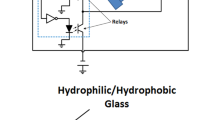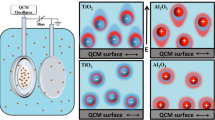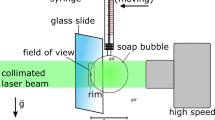Abstract
SOME years ago investigations were carried out concerning attractive forces between glass and quartz bodies with flat polished surfaces1. Due to the well-known hygroscopic behaviour2 of these surfaces, however, silica-gel obstacles were always present on the plates. These obstacles had a tendency to decrease the attractions and even to turn them into repulsions. Therefore metal plates have now been used instead of glass or quartz. The technique used was similar to that described earlier1. The main difficulties were caused by dust particles, and general agreement was found with the conclusions obtained in recent work3 on the influence of dust particles on the contact of solids. Obstacles (smaller than 10µ) are distributed at random on the plates and show, especially in the case of aluminium plates, some ‘compressibility’.
This is a preview of subscription content, access via your institution
Access options
Subscribe to this journal
Receive 51 print issues and online access
$199.00 per year
only $3.90 per issue
Buy this article
- Purchase on Springer Link
- Instant access to full article PDF
Prices may be subject to local taxes which are calculated during checkout
Similar content being viewed by others
References
Overbeek, J. Th. G., and Sparnaay, M. J., Disc. Farad. Soc., 18, 12 (1954).
See, for example, Kohl, W. H., “Materials Technology for Electron Tubes” (Reinhold, 1951).
Williamson, B. P., Greenwood, J. A., and Harris, J., Proc. Roy. Soc., A, 237, 560 (1956).
Casimir, H. B. G., Proc. Kon. Ned. Akad. Wetenschap, 51, 793 (1948).
Lucretius, “De Rerum Natura”, Lib. 1, vs. 385–400.
Newton, I., “Opticks”, query 31 (London, 1717); also “Principia”, Prop. lxxv, Theorema xxxv, and Prop. lxxvi (London, 1686).
Author information
Authors and Affiliations
Rights and permissions
About this article
Cite this article
SPARNAAY, M. Attractive Forces between Flat Plates. Nature 180, 334–335 (1957). https://doi.org/10.1038/180334b0
Issue Date:
DOI: https://doi.org/10.1038/180334b0
This article is cited by
Comments
By submitting a comment you agree to abide by our Terms and Community Guidelines. If you find something abusive or that does not comply with our terms or guidelines please flag it as inappropriate.



